Aeonium Arboreum (Tree Aeonium): Succulent Care Guide (Pictures)

Aeonium arboreum (also called tree Aeonium) is an evergreen succulent plant with thick woody stems, large rosettes, and showy yellow flowers. The species Aeonium arboreum is also called Irish rose, housetree leek, desert pinwheel rose, or tree houseleek. These large subtropical shrubs thrive outdoors in warm, sunny gardens or as indoor houseplants growing in pots.
This article is a complete guide to growing Aeonium arboreum, or the tree aeonium. At the end of the article, you’ll find out how to resolve many aeonium care issues when growing this shrubby succulent.
Aeonium Arboreum Care — Overview
To care for Aeonium arboreum, grow the succulent in porous sandy soil that has excellent drainage. Water the tree aeonium to keep the soil moist without becoming waterlogged. Aeoniums thrive in full sun and a temperature range of 40°F to 100°F (4°C – 38°C). Fertilize in spring and fall.
What is Aeonium Arboreum (Tree Aeonium)?
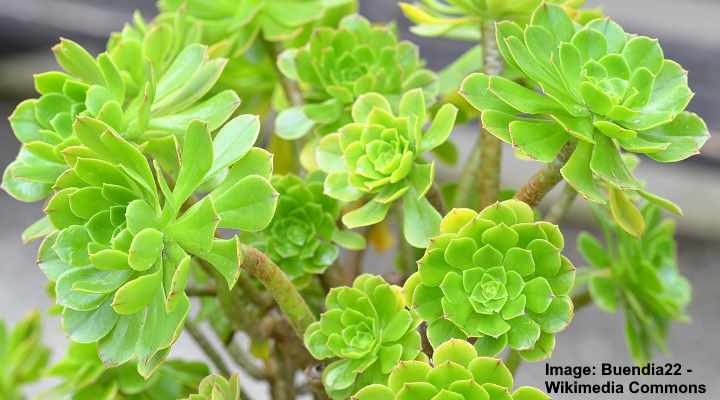
Aeonium arboreum succulents grow as multi-stemmed shrubs and include various cultivars
Aeonium arboreum is one of 35 species of plants in the succulent family Crassulaceae. Most Aeonium species are native to the Canary Islands. They grow in climates with hot, dry summers and warm winters. Tree aeoniums grow as multi-stemmed shrubs up to 6.5 ft. (2 m) tall.
The identifying features of tree aeoniums are their conical flower clusters and large rosettes formed from fleshy leaves. The succulent leaves have a rounded tip and look like a spoon or spatula. These grow in a spiral pattern to create the rosette-shaped foliage. Leaf color is usually light to dark green. Red colors may appear on the leaf margins when tree aeoniums grow in full sun.
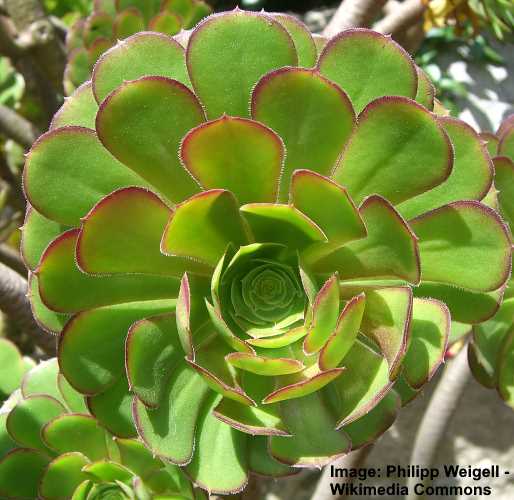
When grown in full sun, aeonium arboreum leaves can have red margins
Tree aeonium (Aeonium arboreum) succulents are relatively fast-growing plants. Unlike many other succulents, the primary growth time of aeonium plants is during the warm winter, spring, and fall months of subtropical climates. During hot, dry summers, the shrubby aeonium succulent goes dormant and requires little care. Aeonium arboreum thrives in USDA zones 9 through 11.
Aeonium arboreum is different from most types of succulents. Although Aeonium arboreum succulents have thick woody stems and fleshy leaves store moisture, they have a shallower root system than other succulents. This fact means that tree aeonium requires more watering than other succulent plants. However, like growing most succulents, you must prevent the soil from being constantly soggy.
In many ways, Irish rose plants look similar to species of echeverias.
Aeonium Arboreum Flowers

Yellow flowers of Aeonium arboreum
Tree aeonium flowers are large pyramid-shaped flower clusters (inflorescence) sitting on the end of long stems. These flowering stems grow between 5” and 20” (12 – 50 cm) long. Each fuzzy conical inflorescence can be as large as 10” (25 cm) tall. Small yellow star-shaped flowers make up each flower head.
Varieties of Aeonium Arboreum
Various tree aeonium cultivars have spectacular colorful foliage in purple, dark purple to black, pink, light green, and variegated colors. Some of the Aeonium arboreum cultivars have daisy-like foliage that looks like large, saucer flowers or roses.
Here are some of the most impressive varieties of tree aeonium:
Aeonium arboreum ‘Atropurpureum’—The “black tree” aeonium has massive dark-purple, maroon glossy rosette leaves. The dark purple houseleek tree succulent grows between 3 and 5 ft. (1 – 1.5 m) tall.

Aeonium arboreum ‘Atropurpureum’
Aeonium arboreum ‘Zwartkop’—This tree aeonium is very similar to the ‘Atropurpureum’ aeonium but has a darker foliage. This succulent has dark-purple almost black elongated spatula leaves. Also called the Black Rose, this Aeonium species grows up to 3 ft. (1 m) tall.

Aeonium arboreum ‘Zwartkop’
Aeonium arboreum ‘Luteovariegatum’—This tree houseleek cultivar is a variegated aeonium succulent with light green, bright yellow, and hints of pink colors. The lovely rosettes grow at the end of 18-inch (45-cm) stalks.
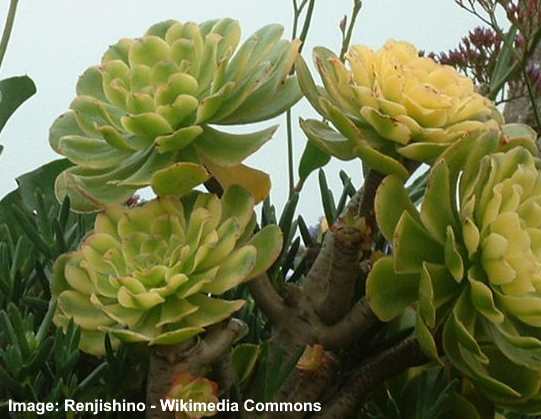
Aeonium arboreum ‘Luteovariegatum’
Aeonium arboreum ‘Velour’—This stunning aeonium has fleshy, spoon-like leaves growing in a huge rosette form. The shiny succulent leaves are a dark burgundy to purple color, and the large round rosette has a bright green center.
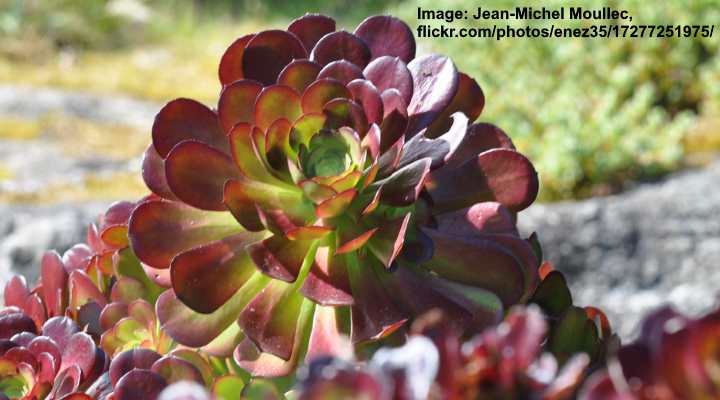
Aeonium arboreum ‘Velour’
Related reading: Different varieties of aeonium succulents.
How to Care for Aeonium Arboreum (Tree Aeonium)
Tree aeoniums are succulents that are easy to care for outdoors if you live in the right climate. All you need to do is keep the ground moist, but not overly damp and protect the housetree leek from direct hot sunlight. The low-maintenance rose-like plants need protection from frost.
Let’s look in more detail at how to grow tree aeoniums in your sunny backyard.
Aeonium Arboreum Light Requirements
The tree aeonium needs to grow in full sun to partial shade for best results. Ideally, aeoniums need six hours of sunlight daily when growing in backyards. Even in summer, when growth is dormant, sunshine keeps the shiny rosette foliage vibrant and healthy.
When growing an Aeonium arboreum in your yard, it’s crucial to remember that too much intense sunlight can burn the foliage. The best place to grow the houseleek tree is where there is partial shade at midday.
Growing potted tree aeoniums indoors also requires natural sunlight. Aeonium arboreum thrives in plenty of bright light, as long as they’re protected from hot sunlight shining directly through the windows.
Aeoniums aren’t plants that thrive on low light. If there’s not sufficient light, the woody stalks become leggy and the rosette foliage sparse.
The Best Soil for Growing Irish Rose (Aeonium Arboreum)
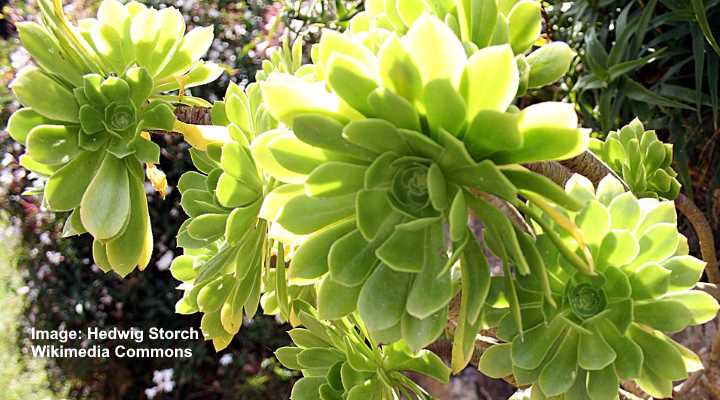
Aeonium arboreum succulents grow best in well draining soil
Plant the Aeonium arboreum succulent in light, porous well-draining soil where it grows best. Prepare the ground by amending the soil with sand and limestone chips. This soil mix creates an aerated planting location so that water drains freely from the tree aeonium. Mulching around the plant stems helps keep the ground moist.
Tree aeoniums are succulents that grow well in containers—indoors or outdoors. Create the ideal succulent soil by mixing two parts perlite or pumice with one part peat moss. This light potting mix allows water to drain freely and prevents soggy potting soil.
Alternatively, you could use a potting mix for succulents by combining one part perlite, one part coarse horticultural sand, and two parts regular potting soil. The light inorganic perlite improves drainage, and the potting soil provides nutrients and retains some moisture.
Related reading: How to make an ideal cactus potting mix.
How to Water Tree Aeonium Succulents
Water Aeonium arboreum plants only as often as the top layer of soil dries out. During warm weather, you may need to water tree aeoniums every seven days. However, in summer—during the dormant phase—you may only need to water the succulents as little as once a month.
The best advice for watering tree aeoniums is to avoid watering on a schedule. Always check the soil for dryness before soaking the ground. Aeonium’s active growth period is in fall, through warm winters, and then spring. Hot, dry weather conditions are when the plant stops growing. So, it’s best to take that into account to keep your plant adequately hydrated but not overwatered.
To water tree aeonium shrubs growing in pots, only water when the top 0.5” (1 cm) of soil is dry. Pour in enough water to reach the roots to keep them moist. The next time to water your plant is when the soil partially dries again.
It’s crucial to remember that overwatering aeoniums results in mushy, yellow leaves and root rot. However, if the soil or ground gets too dry, the fleshy succulent leaves will shrivel and may start to droop.
Unlike most plants, aeonium species are dormant in hot summers. During this time, allow half of the potting mix to dry between waterings.
Top care tip for tree aeoniums: Although they are succulents, tree aeoniums need watering more often than most succulent species.
The Best Temperature for Growing Tree Aeonium
The tree aeonium thrives in temperatures between 40°F and 100°F (4°C – 38°C). The ideal climate for aeoniums is a Mediterranean one. This means dry, warm winters with seasonal rainfall and no freezing temperatures. Tree aeoniums grow best in winter when the nighttime temperatures drop no lower than 50°F (10°C).
Aeoniums are challenging to grow outdoors if you get hot, arid desert-like summers or freezing cold winters with snow.
Do Aeonium Arboreum Plants Need Fertilizer?
Tree aeoniums are light feeders and typically don’t need extra fertilization. Succulent plants growing in the ground grow well without additional nutrients. In fact, too much fertilization in aeonium soil could result in root burn and damage to the plant’s glossy rosette foliage.
You could use a natural, organic houseplant fertilizer to “feed” tree aeoniums growing in containers. For example, apply some worm compost in early spring to encourage healthy growth. However, most aeonium growers report that their succulent potted plants grow fine without fertilizing them.
Aeonium Arboreum Pruning
Tree aeoniums only require pruning to remove dead foliage, eliminate leggy stems, or prevent heavy rosettes from breaking the stems. This plant species generally keeps its shape without pruning. In most cases, pruning is only for aesthetic purposes to improve the aeonium’s appearance.
Tree Aeonium Propagation
The best way to propagate Aeonium arboreum is by rooting stem cuttings. To grow a new tree aeonium, cut off a rosette, leaving about 1” to 2” (2.5 – 5 cm) of the stem on the head. Put the stem in a mix of one part peat moss and one part perlite. Keep the soil moist and put the cutting in a bright warm place.
It takes between two and three weeks for aeonium cuttings to take root. When roots appear, you can transfer the tree aeonium to a larger pot filled with an appropriate potting mix for succulents.
You may notice baby rosettes growing off rosette heads. You can separate these offsets from the plant and place them in a rooting mix to propagate.
Care tip for propagating tree aeoniums: Make sure the cutting is growing in a bright room with temperatures between 64°F and 75°F (18°C – 24°C).
Repotting Irish Rose Plants
To encourage healthy growth, repot Aeonium arboreum every two years in springtime. Gently remove the woody succulent from its original container. Shake off excess dirt from the roots. Then half-fill a new, larger pot with an appropriate potting mix and replant the tree aeonium at the same level as it was growing before.
When repotting tree aeoniums, take care of the stems. The large, heavy rosette foliage can easily cause the branches to break. Also, you may need to stake larger aeonium plants to prevent them from falling over.
Pests Affecting Aeonium Arboreum Growth
The tree aeonium species isn’t generally susceptible to common houseplant pests. If any bugs do cause problems, they are usually spider mites, mealybugs, or aphids. Use a homemade neem oil solution to eradicate bugs and mites from the aeonium rosette foliage. Apply neem spray every seven days for best results.
To make a neem oil solution, mix 2 teaspoons neem oil and 1 teaspoon liquid Castile soap with 1 quart (1 l) lukewarm water. Combine the ingredients thoroughly in a spray bottle. Spray the neem solution liberally on the succulent leaves to get rid of mealybugs, aphids, and spider mites.
To protect your beautiful aeoniums, it’s essential to spot the signs of houseplant infestations. Here is what to look out for:
- Spider mites on aeoniums—Spot spider mites by looking for silky webbing between the fleshy succulent leaves on the rosette head. Some spider mites look like red dots in between leaves.
- Mealybugs on aeoniums—You can recognize mealybugs by the white fuzzy substance they leave behind on aeonium foliage and stems.
- Aphids on tree aeoniums—Aphids are more common on tree aeoniums that grow outdoors. The best way to remove aphids is by hosing them off the plant with a strong jet of water.
Related reading: The complete guide to using neem oil on houseplants.
Diseases Affecting Aeonium Arboreum Growth
Like all succulent species, tree aeoniums are prone to root rot if the plant sits in waterlogged ground. Avoid root rot by watering the plant only when the soil partially dries. If the roots become damaged because of soggy soil and fungal infections, you will have to repot the plant in fresh soil. Unfortunately, extensive root damage may mean that the plant is beyond saving.
Are Aeonium Arboreum Succulents Toxic?
There are no reports that tree aeonium leaves or stems are poisonous for cats, dogs, or other household pets.
FAQs About Aeonium Arboreum Care
Tree aeoniums are generally easy-care succulents that grow well in warm climates. However, some issues can affect Aeonium arboreum care. Here are some handy tips on growing Irish rose succulents outdoors.
Why do the aeonium succulent leaves turn yellow and droop?
Tree aeonium leaves naturally turn yellow and start to droop as they become old. So, limp, yellow leaves on aeonium succulents are typically nothing to worry about. You can remove the few yellow leaves that appear.
Yellow leaves on aeoniums can be a sign of watering issues. If you notice that yellow aeonium leaves are bloated and mushy, you may have to cut back on watering. Shriveled yellow succulent leaves along with parched soil are signs that your plant needs more water.
When do tree aeoniums turn darker colors?
Tree aeoniums such as the ‘Zwartkop’ (Black Rose) and ‘Atropurpureum’ (Black Houseleek Tree) varieties need plenty of sunlight to develop dark leaves. Make sure that the succulents get at least six hours of sunlight daily. However, protect the aeoniums from intense, direct hot sunlight.
How do you look after a tree aeonium in the winter?
The best care for tree aeoniums during winter is to keep the ground slightly moist but not waterlogged. Only water the Irish Rose or Black Rose occasionally to keep some moisture at the roots. If you live in a temperate climate, bring the potted aeonium indoors when the temperature drops below 50°F (10°C).
Why are aerial roots growing from the tree aeonium stem?
It’s natural for species of aeonium to produce aerial roots. Sometimes, aerial roots are a sign that the aeonium needs more water. However, unless you notice other symptoms of care issues—yellowing leaves or drooping growth—you don’t need to worry too much.
What to do with aeonium after flowering?
Tree aeoniums are monocarpic, meaning they die after flowering. To prevent the stalk from dying, cut the bloom stalk after it has finished blooming. You will notice that a small cluster of plants will grow at the cut stalk after a while. However, multi-stemmed aeonium bushes don’t produce blooms from every branch. So, your shrubby succulent should continue growing for many years.
Discover other beautiful types of aeonium succulents.
Related articles:
- Echeveria Types and How to Care for These Succulents
- Types of Jade Plants (Crassula) with Pictures
- String of Dolphins: Succulent Care and Growing Guide
